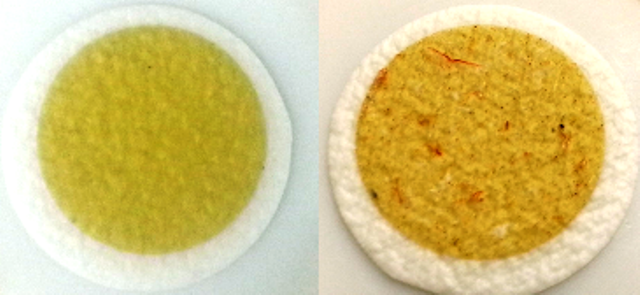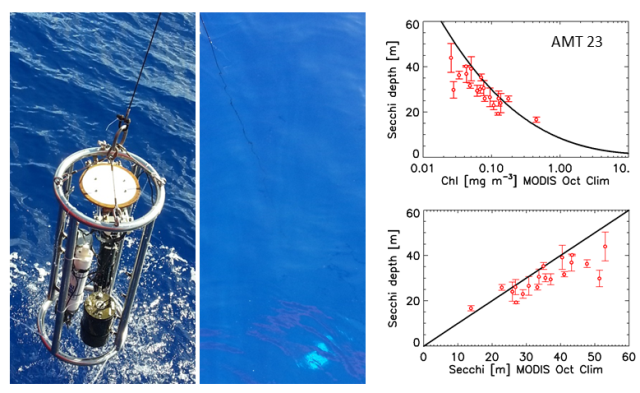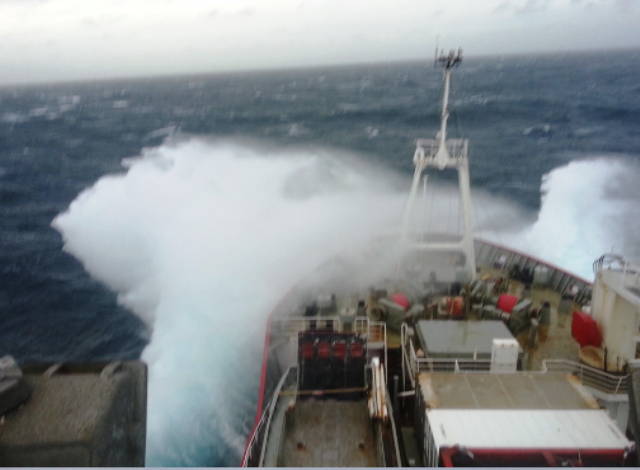From Bob Brewin (Plymouth Marine Laboratory, UK), 4 November – currently doing experiments for ESA aboard the RRS James Clark Ross on the 23rd Atlantic Meridional Transect
We are roughly 40 degrees south and 45 degrees west, heading for the Falkland Islands where we are due to arrive on Saturday. We have two more days of sampling left and I am very much looking forward to (for the first time in two weeks) not having to get up at 4:30 am on Thursday!
We are now in very productive waters. The picture above shows two 25 mm GFF filters that have had 1 litre of surface water (~5 m depth) filtered through them. The colour in the filter is caused primarily by the concentration of phytoplankton in the water.
A few days back, when we were in the very blue waters (see last post), it would probably have taken 6–8 litres of surface water (maybe more) to get anywhere near this colouration.
The yellow colour of the filter is indicative of a phytoplankton community dominated by diatoms and in the right filter you can even spot a red copepod (zooplankton) antenna.
In a space of a day, the ‘Secchi depth’ changed from 35 m to 19 m. A Secchi disk is a 30 cm white disk that is lowered into the water until the point at which it disappears. The depth of disappearance is known as the Secchi depth.
The Secchi disk is one of the oldest bio-optical instruments and has been in use since the late 19th century. In additional to the high-tech bio-optical instrumentation we have on our optics rig (see above), we also attached a Secchi disk. This way we can continue this decadal-long time-series of observations.
The Secchi depth can be related to the concentration of phytoplankton in the water (see figure above). We have compared our Secchi depth measurements taken on this cruise with the average chlorophyll concentration estimated from satellite at the same location in an October climatology (we will use the concurrent chlorophyll concentrations once they are processed after the cruise).
Demonstrated in the figure above, as the chlorophyll concentration decreases (a pigment indicative of phytoplankton biomass) the Secchi depth typically increases. The black line shows the typical relationship between chlorophyll and Secchi depth observed elsewhere in the global ocean. These Secchi depth measurements can also be used to validate algorithms designed to estimate the Secchi depth using satellite ocean-colour data, as demonstrated using the October monthly satellite climatology (bottom right figure above).
As we approached 40 degrees south, we have entered the region of the ocean known as the ‘Roaring Forties’ and have been blasted by 51 knot (Beaufort 10) winds and the ship has been rocking from side-to-side. Hopefully the wind dies down tomorrow, though I am not sure the swell will?
ESA’s Craig Donlon says, “A great benefit of the AMT cruise is the wide range of ocean and atmospheric conditions encountered along the transect – allowing a suite of measurements to be made that sample the processes and conditions that we measure from space. Bon courage as you head into the wilds of our blue ocean planet Bob!”












Discussion: no comments